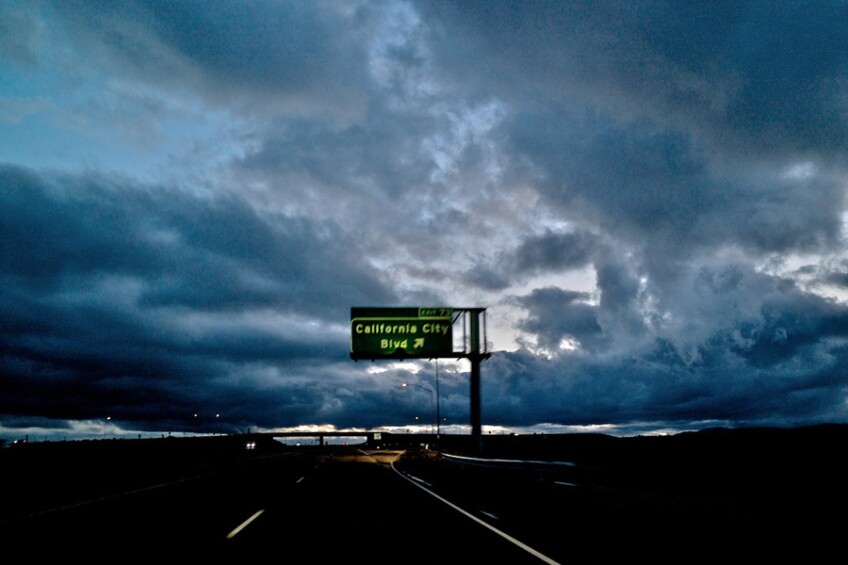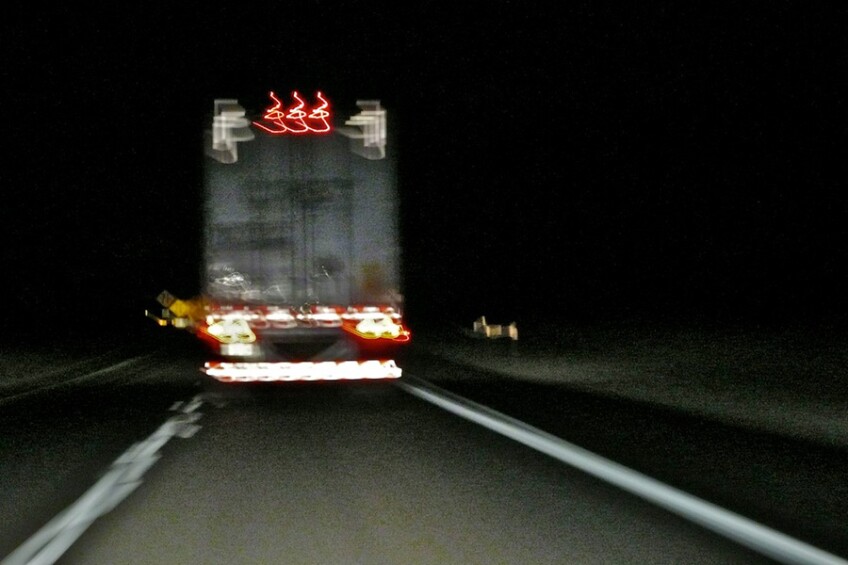High & Dry: Dark Desert Highway

High & Dry surveys the legacy of human enterprise in the California desert. Together, writer/historian Christopher Langley and photographer Osceola Refetoff document human activity, past and present, in the context of future development.
The Eagles made the term "dark desert highway" iconic in their song "Hotel California." Desert highways have unique qualities that "with the wind in our hair" call to us to embark on another life adventure.
For the pioneers, the California desert was solely an obstacle en route to the Promised Land. They saw their life's dream waiting beyond its border, with no possible benefit to the wasteland before them. Highways in the Mojave were created in the name of speed and convenience to entice, mislead and shield us from the healing power of the landscape. There is a price we pay each time we seal ourselves in a car and accelerate on a two or four lane road. The highway is constructed to protect us in comfort and convenience from the land, our anchor, and sense of identity. It is a subtle but heavy price we pay on this dark desert highway journey.

According to William L. Fox, the Mojave Desert contains 54,000 square miles, the smallest of the American deserts, and tiny compared to the Sahara. It also abuts Los Angeles whose population averages, it is estimated, more than 240 billion driving miles each year. Ninety-five percent of the Mojave Desert is within three miles of some kind of road. Twenty-five percent of California is desert. One sixth of the world's population lives in a desert. In 100 years some demographers state that the percent of desert dwellers could jump to 50 percent.
Fox points out, "The interstates were designed to resist attention, to be a transparent part of the landscape." Created in the 1950s, our country's Interstate system changed our culture and greatly affected the economic life of the land. Jumping onto any of the numbered highways in the Mojave (for instance: 395, 14, 40, or 15) and crossing the arid land, travellers hesitate to even stop long enough to walk across a hill, dune or rocky flat. They consciously resist getting dust on their shoes or sand in their socks.
The desert highways give us the choice of observing the view as a flashing and changing series of landscapes vs. experiencing the land with all our senses engaged. Fox calls it "insertion of myself" into the land. Engaging our nervous, muscle and other sensing systems in walking, standing, and kneeling creates powerful memories. These in turn create attachments to the land and a kind of personal anchoring of the self. We know we belong in this place, at least temporarily. Travelling at high speeds in the car erodes any of these memory traces, especially the personal attachment that assists building self-knowledge, identity and a sense of wellbeing.
Travelling at more than 70 miles an hour down the desert highway does permit pull-offs at "scenic points." These scenic points have been selected based on practices of landscape artists that began 400 years ago. Fox comments, "It's a very nineteenth century attitude, closely related to our willingness to design an interstate that essentially ignores the terrain." These spots are elevated to give the viewer a vista to gaze upon. At the same time they isolate the traveller from the land. Looking down at the scene also promotes a false sense of "moral domination of the wonders of nature."
The practices of the nineteenth century painters and photographers have framed the views of many of our national parks including Death Valley and the Mojave Nature Preserve. As we travel, we are forced to see the landscape in a predetermined way, based on dated strategies. Viewpoints, placement of trails and other "engineered" decisions have been forced to match what hangs on the walls of our classic museums. The word "landscape" contains the idea of a fixed or forced point of view frontwards, at but not into the land itself. Just passing through the desert in a high-speed car, the view is framed by windshields, rooflines, and doorframes. When we photograph the scene, we rely on the framed view of the camera to be our memory. It is only a light shadow of what we experienced in the desert.
The Eagles characterized their desert highway as "dark." Travelling at high speeds at night is a very different experience. The eyes focus on headlights. In the case of trucks we are dazzled by an array of different kinds of safety lights. Travelling the desert highway is "dark" in another way. We travel in denial, telling ourselves we have been to the desert. We have only been to a narrow corridor, gazed at predetermined scenes. If we have gotten out, what we perceived has been created by culture and engineered to reflect landscape photography and painting from more than 100 years ago. Photographs taken at high speeds on the desert highways, both at night and in the burning light of noon, point this out. Desert highways are structures calculated to miss the desert as the cars speed through, or to force prearranged scenes, though eerily beautiful, that are far from natural.
Special thanks to William L. Fox, author of "Driving by Memory."
William L. Fox is a writer whose work is a sustained inquiry into how human cognition transforms land into landscape. His numerous nonfiction books rely upon fieldwork with artists and scientists in extreme environments to provide the narratives through which he conducts his investigations. He also serves as the Director of the Center for Art + Environment at the Nevada Museum of Art in Reno.
To explore more High & Dry: dispatches from the land of little rain visit desertdispatches.com or the project's Facebook page. We welcome your questions and comments.


Dig this story? Sign up for our newsletter to get unique arts & culture stories and videos from across Southern California in your inbox. Also, follow Artbound on Facebook, Twitter, and Youtube.


